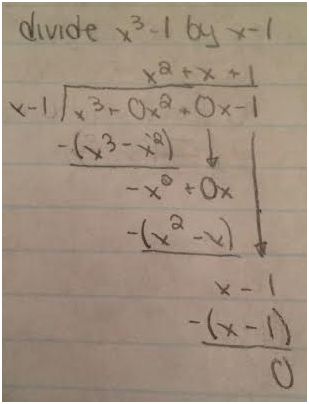Long Division of Polynomials
You can use long division of polynomials to find the real zeros of
polynomial functions. For example:
Steps:
1.
Multiply (x-2) by 6x2 to get 6x3.
2.
Subtract.
3.
Multiply (x-2) by
-7x to get -7x2.
4.
Subtract.
5.
Multiply (x-2) by
2 to get 2x-4
6.
Subtract
You can use this solution
to factor the function completely. This
is true by the remainder theorem, which states that if a polynomial f(x) is
divided by x-k, the remainder is r=f(k).
In other words, if the remainder is zero, it as a factor and follows the
factor theorem, which states that a polynomial f(x) has a factor (x-k) if and
only if f(k)=0.
You can use this
factorization to determine the zeroes of the polynomial function.
As you can see, the zeros
of the function occur at 2, ½, and 2/3.
Now what happens if you have a remainder other than zero?
If you have a remainder
that is other than zero, you divide the remainder by the divisor and add it
into the quotient. For example:
This illustrates the
difference algorithm which states that the dividend equals the divisor times
the quotient times the remainder.
Important
note – always make sure to use placeholders when there are missing terms in the
dividend. For example:
Synthetic Division
Synthetic division is a
nice shortcut for long division; however keep in mind that it works only for dividing polynomials by
divisors of the form x-k. Here is an example:
Divide
Steps:
1.
Set up the array.
Make sure to include placeholders when
there are missing terms in the dividend.
2.
Drop the first
number below the line and multiply it by the number in the upper left corner.
3.
Take the solution
and put it above the line one place to the right.
4.
Add the two
numbers above the line and write the product below the line.
5.
Repeat steps 2-5
until you have reached the final number
6.
If the final
number is zero, there is no remainder.
If the final number is not zero, divide the remainder by the divisor and
add it to the quotient.
A diagram of how the array
is set up is shown below.
Rational Zero Test
The Rational Zero test
relates the possible rational zeroes of a polynomial (having integer
coefficients) to the leading coefficient and to the constant term of the
polynomial. The technical definition is
if the polynomial
has integer coefficients, every rational zero of ƒ has the form Rational
zero=p/q where p and 1 have no common factors other than 2, p is a factor of
the constant term a0, and q is a factor of the leading coefficient an. The
rational zero test essentially tells us that the possible rational roots are
the factors of the constant term divided by the factors of the leading
coefficient. Here is an example of how to use the rational zero test to
solve for the rational zeros of a polynomial:
Normally when trying to solve for rational zeroes, you
randomly plug in the possible rational zeroes and keep trying until one
works. This can be extremely lengthy and
tedious. Instead, if you graph the
function on a graphing calculator, you will be able to calculate its zeroes by
using the CALC function. If the x-value
is one of the possible rational roots, plug it into the upper left corner of
the synthetic division array. It will
result in a zero remainder, meaning it factors cleanly and allows you to get
onto the next step for synthetic division.
In addition, whenever the
coefficients of a function add up to zero, (x-1) will always
equal zero, meaning 1 is a zero of the function.
Works Cited
"Precalculus with Limits: A Graphing
Approach." Precalculus with Limits:
A Graphing Approach. N.p., n.d. Web. 15 Jan. 2015.










No comments:
Post a Comment